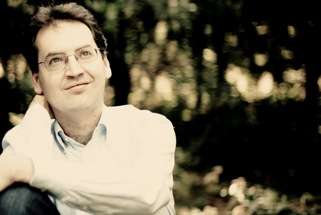|
Back
Good music and coffee too New York
Walter Reade Theater, Lincoln Center
05/07/2017 -
Ludwig van Beethoven: Sonata No. 27 in E minor, op. 90
Béla Bartók: Two Elegies, op. 8b, Sz. 41: No. 1
Franz Liszt: Sonata in B minor
Dénes Várjon (piano)

D. Várjon (© Balázs Böröcz)
I am glad that the Great Performers Series at Lincoln Center included Dénes Várjon, even if his recital was squeezed into one of the smaller venues and took place during morning hours, when many New Yorkers are still having their first cup of coffee and reading the first pages of their Bible...er...The New York Times. At least, as far as coffee is concerned, following the morning concerts at the Walter Reade Theater, the organizers provide their patrons with very good coffee and pastries. As I recently learned, in Vienna there is a similar series of morning recitals at their Konzerthaus, where great artists appear at 11AM, often to a full house. So perhaps I should not complain about the early hour.
The recital programs at the Walter Reade are always on the short side, usually lasting only one hour. But this is not the only reason Mr. Várjon was able to keep us enchanted, for he demonstrated the same unusually high level of piano-playing and music-making we heard from him last season. There is no doubt in my mind that in the generation of pianists “over 40” he has created for himself a niche as one of the most interesting soloists and a fantastic chamber musician. It was in that last guise that I was fortunate enough to hear him several times and I knew that we are dealing with an uncommonly gifted pianist.
Mr. Várjon began his program with the Beethoven I>Sonata in E-minor, a work that stands right on the border of the so-called “middle” and “late” periods. The sonata is very compact and has only two movements – not uncommon in Beethoven’s later works (other examples being sonatas Op. 54, Op. 78 and Op. 111). Here, after an energetic, assertive opening, the prevailing mood is that of thoughtfulness, lyricism and tenderness. The virtuosity we often associate with Beethoven’s writing is really not to be found in Op. 90. Also, we often try to compare Schubert to Beethoven, but seldom do we experience Schubertian character in Beethoven’s music. However, to me the second movement of Op. 90 is one of those “Schubertian” moments.
In this second movement, whose tempo markings may be translated to mean to be played not too fast and in a very singing manner, Várjon achieved a level of serenity that is very difficult to bring about and that one rarely hears. His style of playing in this sonata (and later in some segments of Liszt) is a bit old-fashioned inasmuch as the hands are not always together, yet it never becomes mannered. To my ears, in this facet he reminds me quite a bit of another Hungarian, his older colleague and mentor, Sir András Schiff, who often also displays this long-forgotten manner of performance demonstrated in the past by such masters as Wilhelm Kempff and Mieczyslaw Horszowski.
Bartók’s Elegie No. 1 is the first of two written in 1908-09, during the time of the composer’s disappointing love affair with the violinist Stefi Geyer (to whom he also dedicated his First Violin Concerto). It displays the post-Romantic, tempestuous style of writing similar in my mind to Alban Berg’s Piano Sonata, written at about the same time. A coincidence? Here the Bartók found an ideal, passionate performer in Mr. Várjon. It is a stormy, sometimes turbulent work, yet in its middle part quiets down for a fugato segment that perhaps is homage to a similar section in Liszt’s great B minor Sonata which followed.
The Liszt work is problematic not only because of its virtuosity and strict technical demands – which alone make it one of the pinnacles of the piano repertory – but also because it requires, perhaps more than any other work of the Romantic era, a different type of artistry that has more to do with theater than music alone. The narration is as difficult as any spoken part in any play. Liszt asks here a lot of questions to which there are no immediate answers. The sonata’s middle section is full of recitatives, full of rhetoric, and full of fermatas, all of which indicate some kind of emotional struggle and an elevated sense of drama. And here probably any person that knows the score will see his or her own solutions, especially in matters of timing. Várjon’s solution, in my opinion, was that of a young and still somewhat impatient performer who wanted his answers immediately. But he also had an enormous command of the instrument; his playing was logical and intelligent (I gather he is unable to play an unintelligent phrase!) and even in the most difficult pianistic segments there was clarity of detail and nuance. Unlike some younger players happily banging the loud passages, which in this work are plenty, Mr. Várjon knew how to balance the piano registers and he managed to produce no ugly or harsh sound. If my portrayal may sound like faint praise it is only because his performance of the Beethoven sonata was so unique and unusual in its beauty. I might conclude with the statement that I would go a distance to hear this pianist again. His musicianship is exceptional, his technique never calls attention to itself, and he understands music as few do.
There was only one encore, a lovingly and tenderly played “Warum?” from Schumann’s Fantasiestücke op. 12.
Roman Markowicz
|